Mine! Mine! Mine! (11 May 2007)
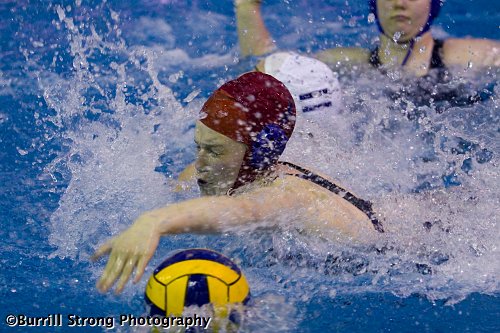
Chelsea water polo goalie Becca Brezee retrieves the ball during the Bulldogs’ playoff match against Mason. Chelsea lost, 4-5.
(Full gallery.)
Mine! Mine! Mine! (11 May 2007)

Chelsea water polo goalie Becca Brezee retrieves the ball during the Bulldogs’ playoff match against Mason. Chelsea lost, 4-5.
(Full gallery.)
Just doing my job (07 May 2007).
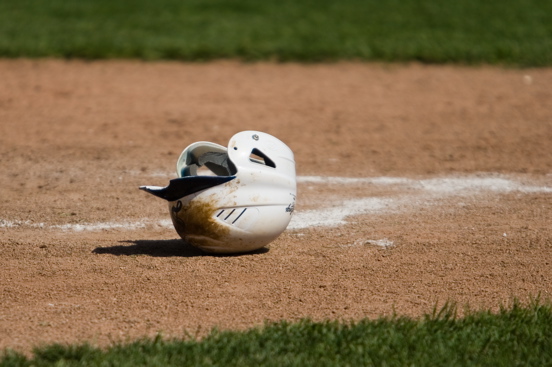
Derek Fairchild’s batting helmet brim shows the effects of its collision with a ball during Saline’s game at Chelsea. The Saline second baseman made contact with a pitch from Chelsea’s Chad Nielsen, but he hit the ball up into his own head, and a piece of the helmet brim shattered on impact. Fairchild immediately went to the ground clutching his head, but the helmet took enough of the impact that he was not seriously injured; he finished his at-bat and played the rest of the game.
Saline defeated Chelsea, 5-2.
(Full gallery.)
Let’s play keepaway (03 May 2007).
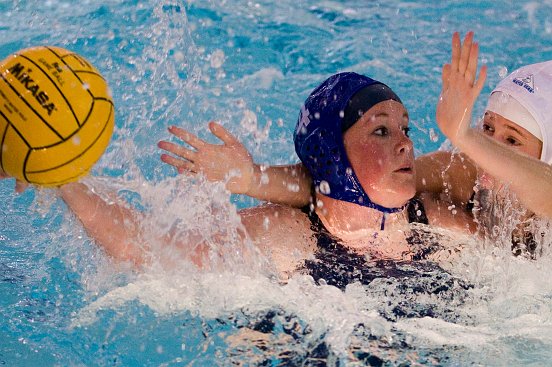
Danielle Schulze fends off a defender during Chelsea’s water polo match against Mason. Chelsea lost, 3-8.
(Full gallery.)
Talk deep into the night; who knows what we’ll find (02 May 2007).




Karin Bergquist and Linford Detweiler, primary members of Over the Rhine (my favorite band), play the first of two shows at the Ark in Ann Arbor; as always, the show was superb.
If you get a chance to see OtR live, take it; they are outstanding.
(See the full gallery.)
Nice to meet you (01 May 2007).
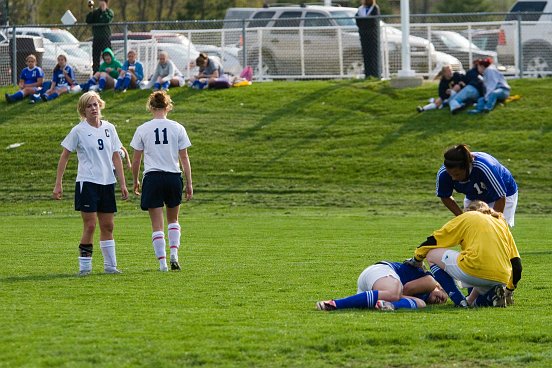
Chelsea soccer player Ellen Stewart (11) walks away after a collision with an Adrian player; Mackenzie Lake (9) looks with concern at the injured player. Chelsea defeated Adrian, 8-0.
Why do I like this picture? Probably because it reminds me of one of my favorite Michigan football pictures.
Lend me a hand (28 April 2007).
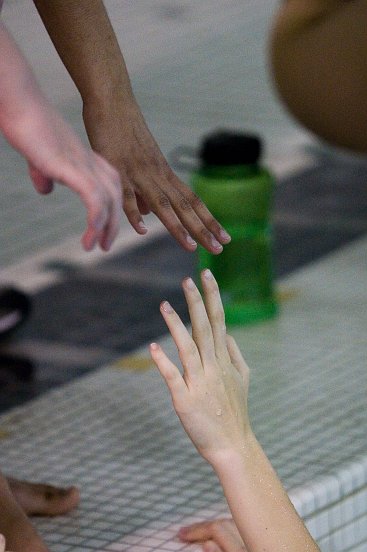
Chelsea water polo players prepare to conclude a timeout during their game against Grand Blanc. After seeing their coach ejected in the third quarter, the Bulldogs faced the task of playing the fourth quarter without a coach; however, due to an injury late in the third, Grand Blanc elected to forfeit.
Digital images frustrate me.
I suppose it might seem odd for me, a photographer with two digital cameras, to make a statement like that; these days, I add several hundred new images a week to the Burrill Strong Photography website. So I should clarify: I’m frustrated not at my images, but at the monitors displaying my images.
The display of digital images is one of the unique complications of digital photography. Printed images are simple and consistent: you can show that picture to any number of people, and the print quality, colors and sharpness will not vary. The hundredth person will see the same picture the first person saw; there will be no unexpected changes.
Unfortunately, an image on the internet does not have the same assurance of consistency; depending on the monitor used to display an image, certain aspects of that image can vary — often slightly, but occasionally significantly. When an image is uploaded for viewing on the internet, the image’s creator is forced to accept this variance as a cost of easy distribution.
For snapshots, the monitor problem is scarcely relevant; the details of color accuracy and proper exposure are not high considerations in the realm of point and shoot memories. If the content is recognizable, the image is ready for distribution.
For those in the business of photography, it is not quite that simple. Since I am in that business, I’m not just tossing images around the internet to share memories; I’m producing images for which I expect customers to give me actual money, so I have to produce images that customers will see as being worth actual money. And that means paying attention to those details of color accuracy and proper exposure (among other things) so that the printed images I sell will be worth buying.
To aid my pursuit of images worth actual money, I made a point to purchase a monitor known to be good for photo work; when I process images using that monitor, I can be confident that the images I see on the monitor will not surprise me by being different when I print them. I know I don’t have to compensate for my monitor’s shortcomings, and that confidence makes my task easier.
The problem begins when I put my images online for public viewing. I know I can trust my monitor, but I also know that I can’t trust most of the monitors that will be displaying my images; higher-end monitors — like the Apple Cinema line — cost more than the average Best Buy offering, and most people don’t have a reason to spend that extra money on a monitor.
On one hand, I can’t say I blame the consumers who buy the $200 19″ LCD monitors. It’s an LCD, it’s 19 inches, and it’s $200; that is an attractive set of features in one place. And really, it would be impossible for me to convince those consumers to spend three times as much on a monitor they’ll be using only for basic web surfing and word processing. Normal everyday web surfing is hardly detail-critical work, and $200 is much more appealing than $600.
On the other hand, for me as a photographer who makes an effort to produce quality images, it’s frustrating to have to trust those images to the average — or worse — monitors used by those who view my work online. Those images will look good enough, but the quality that would be apparent on a good monitor or in print won’t show as it should on a cheap monitor.
By itself, that wouldn’t even be so bad. If I could count on the users of subpar monitors to judge images within the context of their monitors, the preponderance of those monitors wouldn’t be such a significant concern; in a perfect world, I could expect a general understanding that these monitors aren’t doing the images any favors.
But I can’t expect that sort of understanding from everyone, so I’m left knowing that some potential customers, after viewing my images on a low-quality monitor, might decide the images are not worth the money. And if their monitors’ shortcomings had an effect on their decisions, it’s frustrating for me because that’s something over which I have absolutely no control. I can make images that look good on quality monitors and in print, but I can’t make cheap monitors better.
Fortunately, I suspect there aren’t hordes of people who let their cheap monitors affect their decisions to a significant degree, so I don’t need to spend my days fretting about the business these monitors might cost me. But it is still in the back of my mind, so, as a photographer, let me make this request: either buy a good monitor or remember that you didn’t buy a good monitor — and remember that the images you see will look better in print than they do on that monitor.
(More reading: an explanation of the different types of LCD panels.)
The cleft of the tree (24 April 2007).

Across the road from my house, a dandelion found an interesting place to grow: a foot or two off the ground in a tree trunk. It seems like the arrangement would make a good metaphor.
Running on cloud nine (20 April 2007).
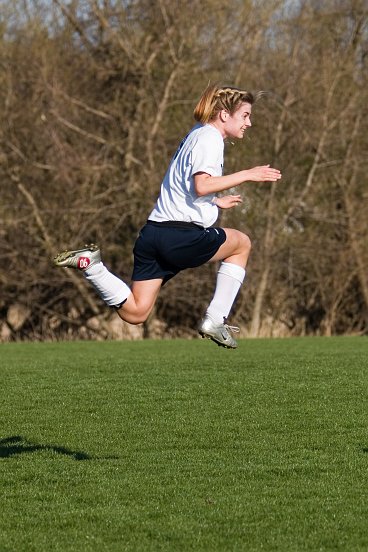
Here’s your chance. What should the caption be for this photo?
(I expect outstanding contributions from all of you, but here’s the basic information: the player pictured is Mackenzie Lake, and Chelsea beat Parma Western, 3-0. See the full gallery.)
Leapin’ Bulldog! (13 April 2007)
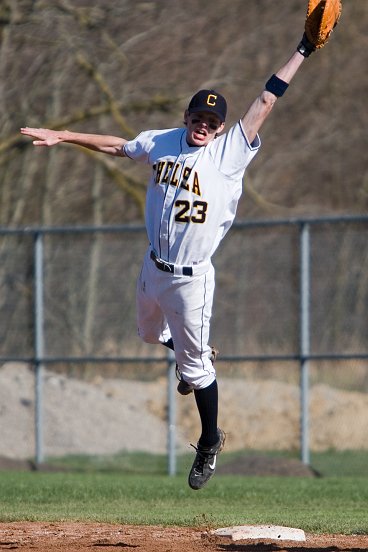
Chelsea first baseman Ben Bradburn leaps for an errant throw during the Bulldogs’ season-opening game against Milan. He couldn’t make the catch, but Chelsea still won, 12-2. The teams played only one game due to the wet field.